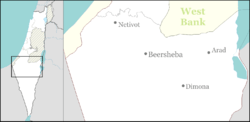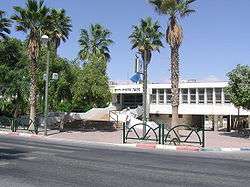Yeruham
Yeruham
| ||
|---|---|---|
| Hebrew transcription(s) | ||
| • ISO 259 | Yroḥam, Yruḥḥam | |
 | ||
| ||
 Yeruham | ||
| Coordinates: 30°59′18.53″N 34°55′40.62″E / 30.9884806°N 34.9279500°ECoordinates: 30°59′18.53″N 34°55′40.62″E / 30.9884806°N 34.9279500°E | ||
| District | Southern | |
| Founded | 9 January 1951 | |
| Government | ||
| • Type | Local council | |
| • Head of Municipality | Michael Biton | |
| Area | ||
| • Total | 38,584 dunams (38.584 km2 or 14.897 sq mi) | |
| Population (2015)[1] | ||
| • Total | 9,078 | |
| Website | www.yeruham.co.il | |
Yeruham (Hebrew: יְרוּחָם, יְרוֹחַם, Yeroham) is a town (local council) in the Southern District of Israel, in the Negev desert. It covers 38,584 dunams (~38.6 km²) and had a population of 9,078 in 2015. It is named after the Biblical Jeroham. The mayor of Yeruham was Amram Mitzna but his term ended in early 2011, and he was succeeded by Michael Bitton of Kadima, who was elected mayor in November 2010.[2]
For many years, Yeruham was economically depressed and suffered from image problems, but major efforts to improve the quality of life are under way.[3]
History
Antiquity
Yeruham is the site of Tel Rahma, dating back to the 10th century BCE. On the outskirts of Yeruham is an ancient well, Be'er Rahma (באר רחמה). Some archeologists have identified it as the well where the biblical Hagar drew water for her son Ishmael.
During the Roman and Byzantine period there was a Nabatean village in the western outskirts of the town and it's ruins can be seen today.
Modern era
Modern Yeruham was founded on 9 January 1951 as Kfar Yeruham (Hebrew: כְּפַר יְרֻחָם) and was one of Israel's first development towns, created to settle frontier areas in the early days of the state. It was located near the Large Makhtesh, an area thought at the time to be rich with natural resources.[4]
The first influx of immigrants came from Romania, many of them Holocaust survivors, followed by immigrants from North Africa, Persia, India and elsewhere, who make up the majority of the town's population today (appr. 40%, 5%, 20%, 10% respectively). By 1961, the town's population was 1,574. The name was changed to Yeruham in 1962.[4] Yeruham was originally founded on the Petroleum Road in the Negev (today roads 224 and 225) and its initial growth was stymied by the construction of Highway 25 and the Beersheba – Mitzpe Ramon section of Highway 40, which created a new route to Eilat and made the Petroleum Road obsolete.[5]
Since autumn 1990, Yeruham is actively involved in absorbing hundreds of olim from the Former USSR, who comprise 25% of the town's nearly 10,000 residents. In recent years young couples and families from other localities have moved to Yeruham, and some have purchased lots and built their homes in the town’s new neighborhoods.
Members of the "Young People in Yeruham" Student Settlement Group are involved in local social action projects, organize cultural events for young people, and attract young people to settle in Yeruham. In April 2008, the Ayalim Student Village opened in Yeruham to allow students in Negev institutions of higher education to live and volunteer in the town. North American students from Nativ College Leadership Program engage in volunteer community service in Yeruham every spring. They help teach English in the local high schools and yeshivot, work with the Magen David Adom ambulance corps, teach in preschools and much more.
Geography
Yeruham is situated in the northern Negev, 15 km from Dimona, 520 meters above sea level.
Economy
The main employers are local and regional industry (53% of employed residents) and services and commerce. Most of those are employed in industry work in local factories such as Agis-Perrigo (Careline cosmetics and pharmaceuticals), Negev Ceramics, Phoenicia Glass Works (which moved to Yeruham from Haifa in 1968)[6] Brand Metals, Ackerstein, Yehu Clays, TTK electronics, and Tempo (some of which utilize raw materials from the region). The rest of those employed work in the surrounding region in companies such as, Ramat Hovav, Negev Nuclear Research Center, Dead Sea Works, Soroka Medical Center in Beer Sheva, Ben-Gurion University, and in Sde Boker. Yeruham has suffered in the past from high unemployment rates, although today the rate is lower than the national average.
Tourism projects include development of the Lake Park around Yeruham Dam and Large Makhtesh. Professional training programs in computers, chemistry, engineering and other fields needed by industry. Local industrial zones have doubled in size and offer space for rental and construction.
Up to 2011, residential construction in Yeruham had been done in a non-profit manner, either by Amidar or the residents themselves. In anticipation of military personnel moving into Yeruham to server in the future adjacent City of Training Bases, land had been released for private for-profit construction.[7]
Education

Yeruham has created a number of kindergartens, nursery schools, and day care centers to accommodate about 800 pre-school children. Yeruham's formal educational system includes 5 elementary schools (State-General and State-Religious, and 3 smaller Ultra-Orthodox schools), and a comprehensive high school affiliated with ORT, where the "Anyone Can Do It" program has consistently raised the number of those eligible for Bagrut matriculation certificates to twice the national level. All schools in Yeruham use GBS, an online system which enables pupils to work at home on material from school. The "City Plays Music" program provides musical education to pupils in all the elementary schools, and organizes two orchestras for more advanced pupils.
The Bilvav Shalem high school yeshiva for boys and the Kamah junior high for girls attract pupils from all over the region and the country. The Yeshivat HaHesder Yerucham (institute of higher Jewish religious education for men combining study with army service), and founded over a decade ago, attracts students from all over the country, and runs a special leadership program for Ethiopian young men. Midreshet Be'er offers a track for religious young women who graduate high school: a year of study and communal-educational experience in Yeruham, two years of IDF or National Service, usually in educational roles, and a final half-year of social action projects in Yeruham.
Over 250 residents study in institutions of higher education, especially in Beer Sheva. Education and training for over-30 adults are coordinated by the Ofek Center for Human Resources Development.
Joint programs with the Weizmann Institute, Ben-Gurion University, the Open University, the Hebrew University Center for Enrichment in Education, and volunteer tutoring by scientists at the Nuclear Research Center – all aim to improve educational achievements and personnel and provide enrichment, especially in the sciences.
Culture
The Yeruham Matnas (Local Community Center) organizes many social and cultural activities which include plays, performances, summer events, subscription series for children and adults, music lessons in the Music Conservatory, sports activities and workout room in the renovated Sports Hall, nature-oriented extracurricular activities, neighborhood clubs, immigrant absorption activities, a Yiddish choir, and communal theater group. The Library has 60,000 books in Hebrew, Russian, English, and Marathi, which is an Indian language, and offers enrichment activities for pre-school and elementary school students, meetings with authors, computer training, workshops for parents and children, a creative writing group, and more.
The Youth Department of the MATNAS is responsible for the "Machsan 52" youth club, youth rock bands, two youth councils (older and younger) which organize activities for local youth, and for the Scouts (including Sea Scouts) and Bnai Akiva youth movements. Midreshet Beyahad Seminar Center and youth hostel provides guided hikes, workshops, and other programming for visiting groups, mainly students, as well as Jewish programming in local schools.
Atid BaMidbar R.A. initiated the "Teudat Zehut" (Yeruham Identity Card) project for community empowerment through documentation, and the BAMIDBAR Regional Center for Creative, Pluralistic Jewish Renewal. The association runs weekly programs of study and encounter integrating creative arts related to Jewish heritage for children, youth and adults of all backgrounds from Yeruham and all over the Negev, cultural and communal events, teacher training workshops, and special programs for visiting groups, as well as a communal archives and volunteer projects.
Yeruham is also widely known to have the best slides in Israel according to students on Nativ College Leadership Program.
Sister cities
References
- ↑ "List of localities, in Alphabetical order" (PDF). Israel Central Bureau of Statistics. Retrieved 16 October 2016.
- ↑ http://www.israelnationalnews.com/News/Flash.aspx/198526,
- ↑ Yeruham calls elections overrated Haaretz, 28 October 2007
- 1 2 Livni, Shimshon (1994). Gardus, Yehuda; Shmuel, Avshalom, eds. The Land of the Negev (English title) (in Hebrew). Ministry of Defense Publishing. p. 588.
- ↑ Livni, Shimshon (1994). Gardus, Yehuda; Shmuel, Avshalom, eds. The Land of the Negev (English title) (in Hebrew). Ministry of Defense Publishing. pp. 590–592.
- ↑ Phoenicia Glass Works
- ↑ Sasson-Azar, Shirly (September 4, 2011). "Exclusive to Calcalist: Yeruham Dons Uniforms". Calcalist (in Hebrew). Retrieved September 4, 2011.
- ↑ http://www.visitlakecounty.org/internationalguide-sistercities.cfm
- ↑ http://jewishmiami.org/about/departments/israel_overseas/miami-yerucham_partnership/index.html/internationalguide-sistercities.cfm
External links
| Wikivoyage has a travel guide for Yerucham. |
